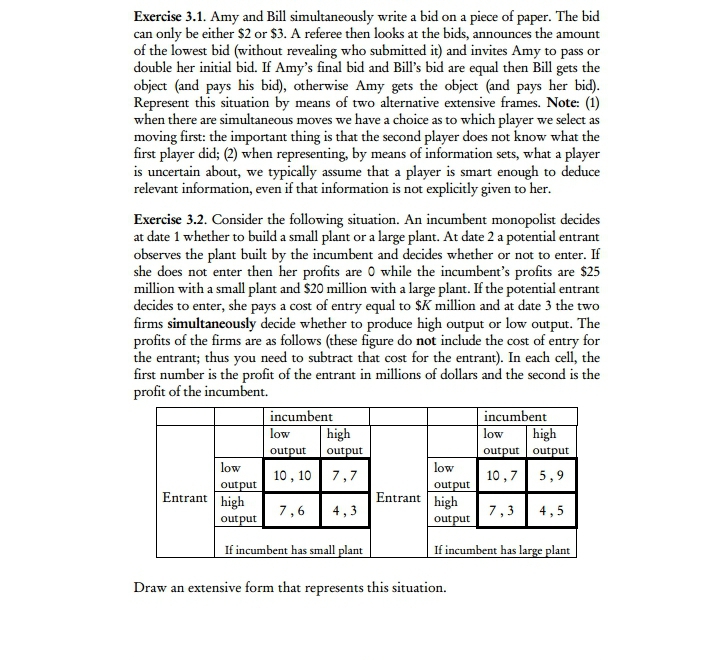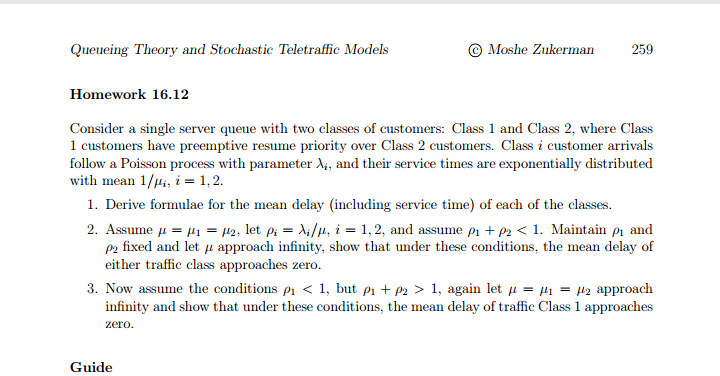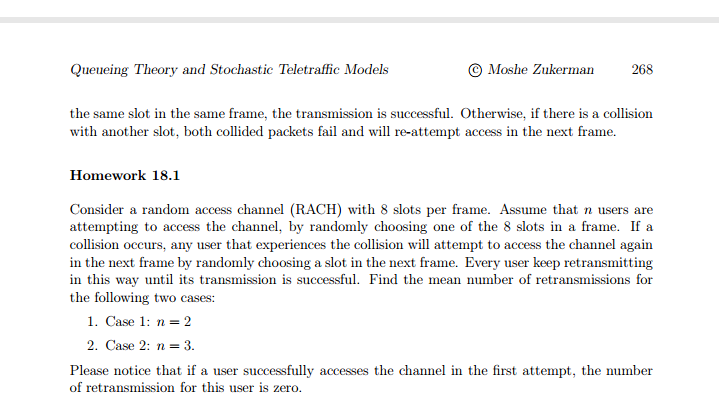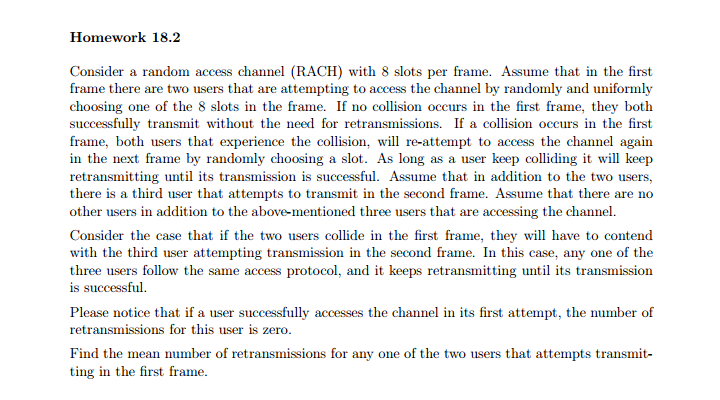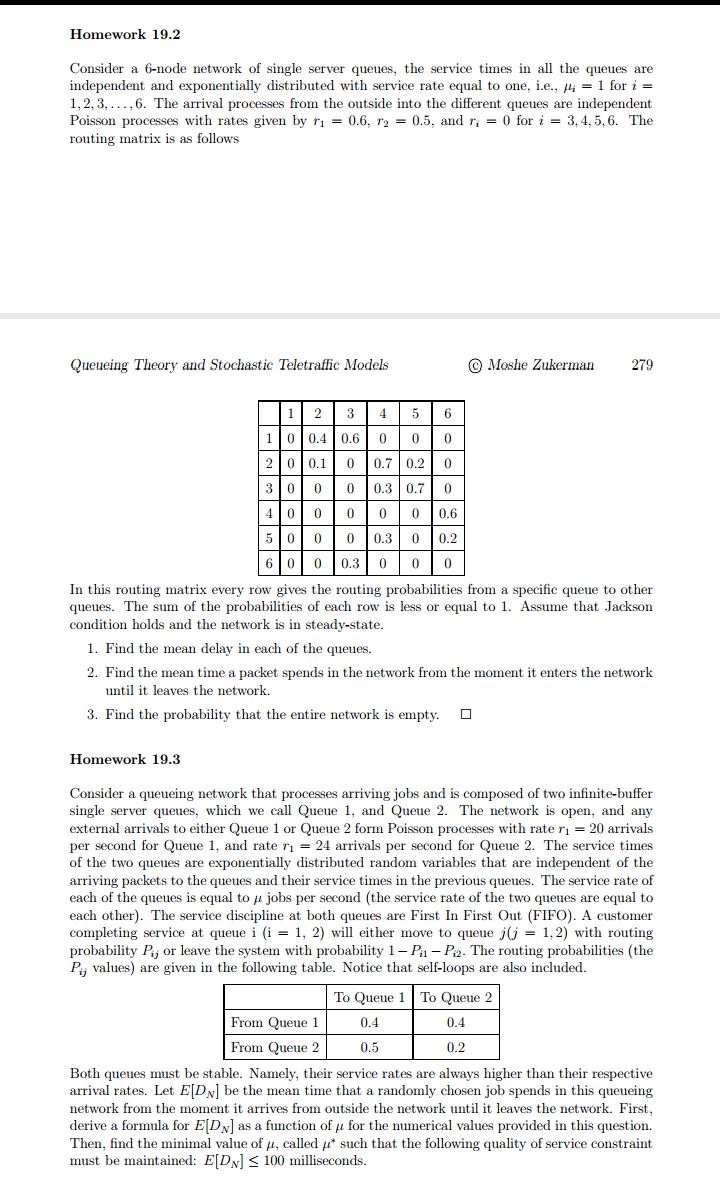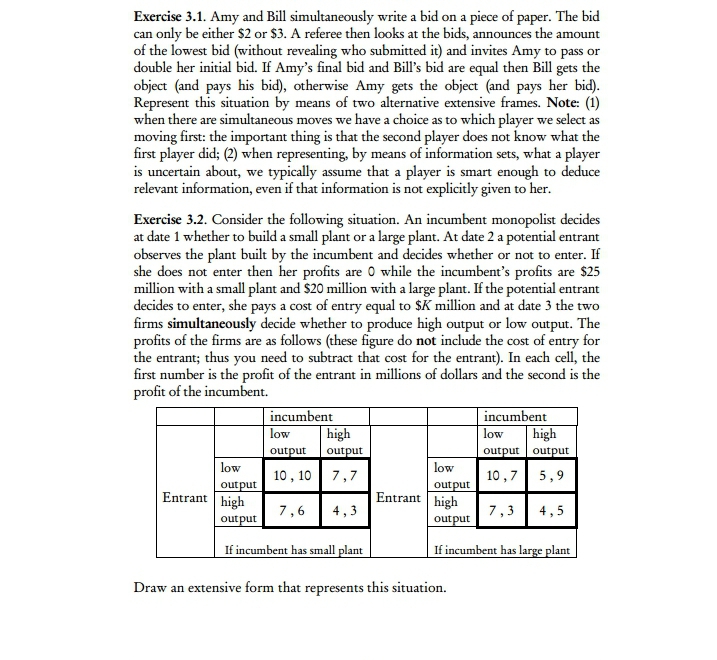

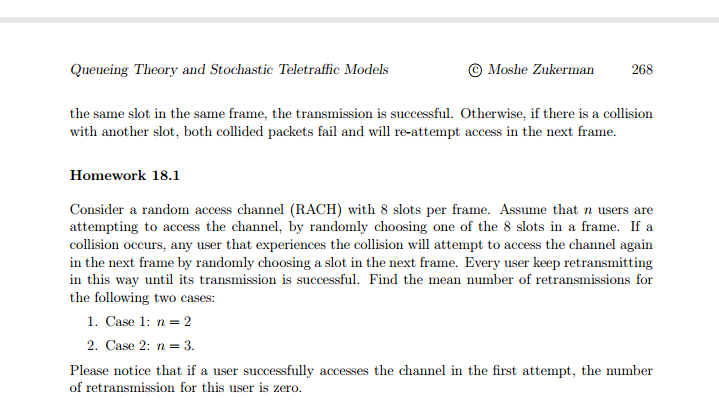
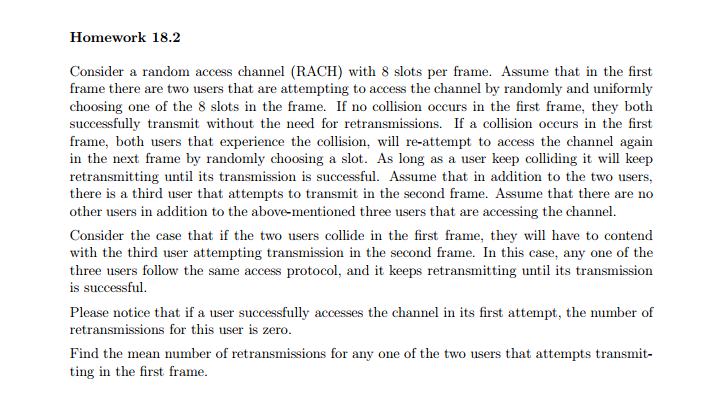
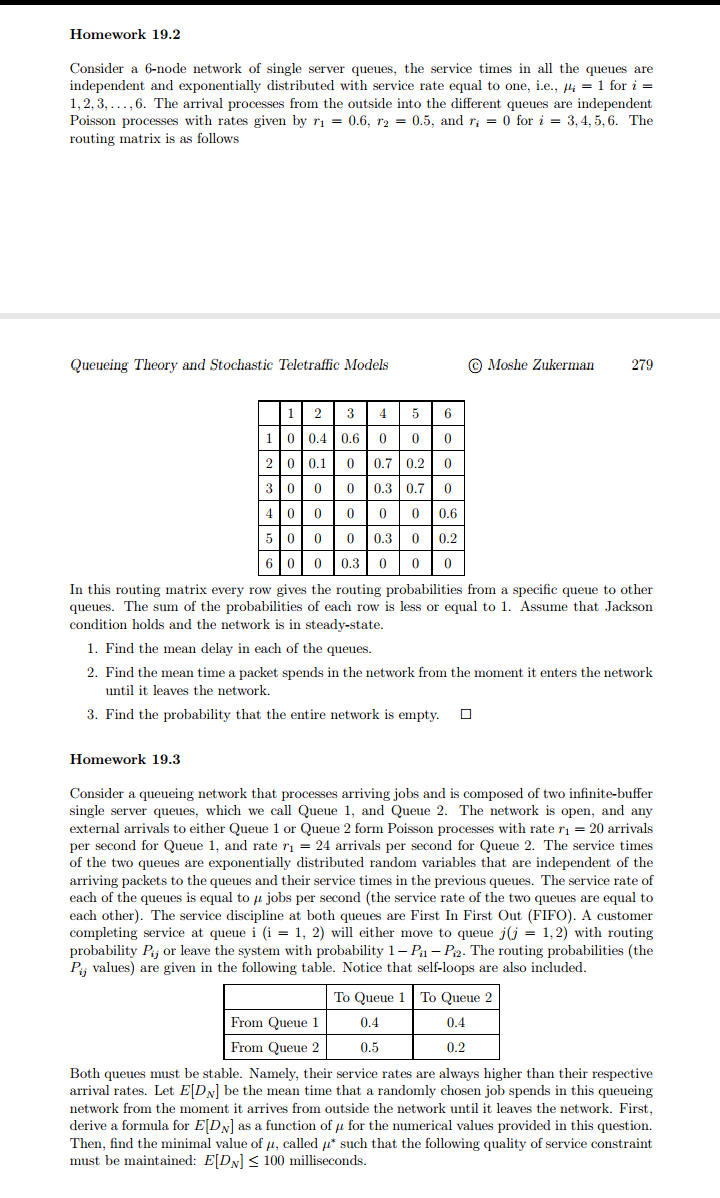
Queuing theory question,thanks
Exercise 3.1. Amy and Bill simultaneously write a bid on a piece of paper. The bid can only be either $2 or $3. A referee then looks at the bids, announces the amount of the lowest bid (without revealing who submitted it) and invites Amy to pass or double her initial bid. If Amy's final bid and Bill's bid are equal then Bill gets the object (and pays his bid), otherwise Amy gets the object (and pays her bid). Represent this situation by means of two alternative extensive frames. Note: (1) when there are simultaneous moves we have a choice as to which player we select as moving first: the important thing is that the second player does not know what the first player did; (2) when representing, by means of information sets, what a player is uncertain about, we typically assume that a player is smart enough to deduce relevant information, even if that information is not explicitly given to her. Exercise 3.2. Consider the following situation. An incumbent monopolist decides at date 1 whether to build a small plant or a large plant. At date 2 a potential entrant observes the plant built by the incumbent and decides whether or not to enter. If she does not enter then her profits are 0 while the incumbent's profits are $25 million with a small plant and $20 million with a large plant. If the potential entrant decides to enter, she pays a cost of entry equal to $K million and at date 3 the two firms simultaneously decide whether to produce high output or low output. The profits of the firms are as follows (these figure do not include the cost of entry for the entrant; thus you need to subtract that cost for the entrant). In each cell, the first number is the profit of the entrant in millions of dollars and the second is the profit of the incumbent. incumbent incumbent low high low high output output output output low low 10 , 10 7, 7 10 , 7 5,9 output output Entrant high Entrant high 7,6 4, 3 7,3 4 ,5 output output If incumbent has small plant If incumbent has large plant Draw an extensive form that represents this situation.Queueing Theory and Stochastic Teletraffic Models @ Moshe Zukerman 259 Homework 16.12 Consider a single server queue with two classes of customers: Class 1 and Class 2, where Class 1 customers have preemptive resume priority over Class 2 customers. Class i customer arrivals follow a Poisson process with parameter ,, and their service times are exponentially distributed with mean 1/m, i = 1, 2. 1. Derive formulae for the mean delay (including service time) of each of the classes. 2. Assume / = /1 = /2, let p; = M/p, i = 1, 2, and assume p, + p2 1, again let a = /1 = /2 approach infinity and show that under these conditions, the mean delay of traffic Class 1 approaches zero. GuideQueueing Theory and Stochastic Teletra'ic Models ([2) Moshe Zulcermau 2E3 the same slot in the same frame, the transmission is successful. Otherwise. if there is a collision with another slot. hoth collided packets fail and will re-attempt access in the next frame. Homework 18.1 lConsider a random access channel {EACH} with 3 slots per frame. Assume that n users are attempting to access the channel. by randomly choosing one of the 3 slots in a frame. If a collision occurs. any user that experiences the collision will attempt to access the channel again in the next frame by randomly choosing a slot in the next frame. Every user keep retransmitting in this way until its transmission is successful. Find the mean number of retransmissions for the following two cases: 1. Case 1: n. = 2 2. Case 2: n. = 3. Please notice that if a user suocemfully accesses the channel in the rst attempt, the number of retransmission for this user is zero. Homework 18.2 Consider a random access channel (RACH) with 8 slots per frame. Assume that in the first frame there are two users that are attempting to access the channel by randomly and uniformly choosing one of the 8 slots in the frame. If no collision occurs in the first frame, they both successfully transmit without the need for retransmissions. If a collision occurs in the first frame, both users that experience the collision, will re-attempt to access the channel again in the next frame by randomly choosing a slot. As long as a user keep colliding it will keep retransmitting until its transmission is successful. Assume that in addition to the two users, there is a third user that attempts to transmit in the second frame. Assume that there are no other users in addition to the above-mentioned three users that are accessing the channel. Consider the case that if the two users collide in the first frame, they will have to contend with the third user attempting transmission in the second frame. In this case, any one of the three users follow the same access protocol, and it keeps retransmitting until its transmission is successful. Please notice that if a user successfully accesses the channel in its first attempt, the number of retransmissions for this user is zero. Find the mean number of retransmissions for any one of the two users that attempts transmit- ting in the first frame.Homework 19.2 Consider a {En-node network of single server queues, the service times in all the queues are independent and exponentially distributed with service rate equal to one, i.e., H = 1 for i = 1,13,. ...6. The arrival processes from the outside into the different queues are independent Poisson processes with rates given by n = [1.6, r; = 0.5, and r; = U for i = 3, 4, 5, E. The routing matrix is as follows Queueing Theory and Stochastic Teletra'ic Models {[2} Moshe Zulrerman 279 In this routing matrix every row gives the routing probabilities from a specic queue to other queues. The sum of the probabilities of each row is less or equal to 1. Assume that Jackson condition holds and the network is in steady-state. 1. Find the mean delay in each of the queues. 2. Find the mean time a packet spends in the network from the moment it enters the network until it leaves the network. 3. Find the probability that the entire network is empty. El Homework 19.3 Consider a queueing network that procemes arriving jobs and is composed of two innite-huiter single server queues, which we call Queue 1, and Queue 2. The network is open, and any external arrivals to either Queue 1 or Queue 2 form Poisson processes with rate r1 = 2|} arrivals per second for lQueue l, and rate in = 24 arrivals per second for lQueue 2. The service times of the two queues are exponentially distributed random variables that are independent of the arriving packets to the queues and their service times in the previous queues. The service rate of each of the queues is equal to p. jobs per second (the service rate of the two queues are equal to each other}. The service discipline at both queues are First In First Gut {FIFO}. A customer completing service at queue i (i = 1, 2} will either move to queue jj = 1,2} with routing probability P};- or leave the system with probability 1 H1 Pa. The routing probabilities (the E,- values] are given in the following table. Notice that self-loops are also included. 5m Rom Queue 2 Both queues must be stable. Namely, their service rates are always higher than their respective arrival rates. Let E[DN] be the mean time that a randomly chosen job spends in this queueing network from the moment it arrives from outside the network until it leaves the network. First, derive a formula for E[DN] as a function of a for the numerical values provided in this question. Then, nd the minimal value of u, called if such that the following quality of service constraint must be maintained: E[DN] g 100 milliseconds





